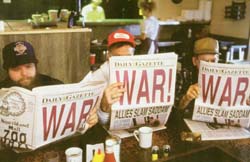Documenting War
“Risk is at the center of [wartime journalism]; there is an elemental equation at work: The better the story or film clip, the greater the risk. They cover wars for a combination of reasons – it’s a great story and it’s where the action is, and it is for any journalist the ultimate test of resourcefulness and courage.”
So writes David Haldberstam in the forward to “From the Front: The Story of War,” a book written by Michael Sweeney, a journalism professor at Utah State University.
The offer to write the book came as a surprise to Sweeney.
One day he received a phone call. The caller said, “I am from a large publishing company you have heard of, and they want to publish a book on wartime journalism as soon as
possible.”
“I said, ‘It sounds to me like I would be interested,'” Sweeney said.
Soon after a deal was struck, National Geographic felt that after the events of Sept. 11, it would be a good time to produce a book on wartime journalism. Sweeney said he was chosen because he was familiar with the subject matter. He was also trained as a journalist and could write in a hurry.
During his research for the book, Sweeney came to appreciate the extreme dedication that most combat journalists need to
possess.
“Their dedication to their craft is intense,” he said.
Ernie Pyle is one of the writers Sweeney admires most. Pyle’s dedication was amazing.
“Army psychologists say that a human being can only stand 100 days of combat before they go stark raving nuts, but Pyle went back into combat time after time,” Sweeney said. “He figured as long as there was a war, he had to cover it, because it was his duty to the American people.”
He said the other thing he liked about Pyle was he reported only what he could see and hear. Pyle gave small slices of life during the war. He told the story of an engineer, artilleryman or infantryman and their experiences.
“If you read his columns over a period of time, you could assemble a larger picture of the war,” he said.
Sweeney said this book might be able to broaden people’s perspective on what journalists have to do.
“I think it’s important for Americans to get as much good information about the war as they can while it’s going on, because we need that information to decide what to do,” Sweeney said.
To support their leaders, or to support a policy or change in policy, Americans need information to make informed decisions and that is why they need wartime journalists, he said.
When a republic goes to war, the people do not know exactly what war is like, Sweeney said. The only way for information to get to the American people is either through the military or through the eyes of an observer.
“The military giving us our information is fine, but their objective is to win,” Sweeney said. “And it’s possible that they may not be bringing us a full, true, accurate picture of what is going on.”
The problem with reporting during war is that they are different in the way wars are covered, he said. The current war, for example, has better coverage than the first gulf war because of the live pictures from the ground. Citizens have a better perspective on what war is really like and what journalists have to do to bring it to them.
Sweeney’s new book documents wartime journalism from the Civil War to the war on terrorism. It is currently available for purchase at Chapter Two Books or online at Amazon.com.
-kassrobison@cc.usu.edu

“The war was the biggest story of all time, it was close to the lives of everyone, and virtually everyone read about it avidly, week after week, for three and a half years,” said Ben Hibbs of the Saturday Evening Post. The quote can be found in Michael Sweeney’s new book about journalism and war. (Photo courtesy Michael Sweeney)

Michael Sweeney, a journalism professor at Utah State University, has recently had a book published by National Geographic. His new book, “From the Front (Photo by John Zsiray)

